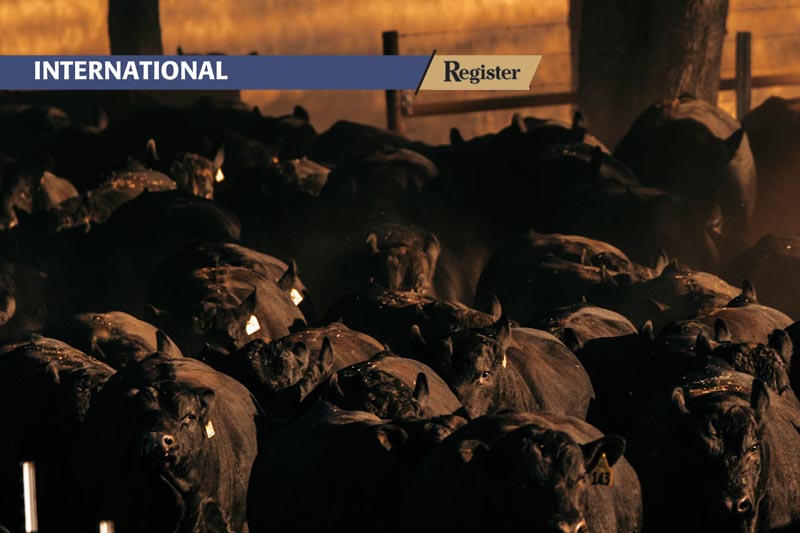What Do Foot-and-Mouth Disease Outbreaks in Europe Mean for the US?
by Jennifer Shike, Bovine Veterinarian
Foot-and-mouth disease (FMD) is rearing its ugly head in Europe. After an outbreak in water buffalo in Germany in January, an outbreak in cattle in Hungary in early March and an outbreak in cattle in Slovakia last week, why now? What is the US doing to keep this foreign animal disease out and protect the country’s livestock industry?
“FMD is caused by a virus that affects cloven-hoofed animals, including cattle, pigs, sheep, and goats,” explains Megan Niederwerder, DVM, who serves as the executive director of the Swine Health Information Center (SHIC). “It does not affect humans and is not a threat to food safety, but it has significant trade implications once it is introduced into a country.”
FMD has been fairly quiet in these European countries, with no cases reported for decades. Other parts of Europe have seen outbreaks more recently, like the 2001 outbreak in the United Kingdom that caused a crisis in British agriculture and tourism, and resulted in the cancellation of the World Pork Expo held in Des Moines, Iowa.
“FMD really decimated the United Kingdom,” says Barb Determan, who was serving as president of the National Pork Producers Council (NPPC) at the time. “It became very apparent that we couldn’t guarantee the safety for our US pig herd because of the high numbers of international travelers that would be at the show. We had to cancel the World Pork Expo out of an abundance of precaution.”
That was the first time, but not the only time the World Pork Expo was canceled. The event was also canceled in 2019 because of the African swine fever outbreak in China, and again in 2020 due to the COVID-19 pandemic. “That was a hard financial decision,” Determan says. “We had just completed the separation agreement between NPPC and the National Pork Board. NPPC was very tightly budgeted at that time, so it was a huge hit.”
However, keeping the US pig herd safe was the most important thing on everyone’s mind. She says they made their decision after hearing reports from veterinarians who had been to England to better understand the extensiveness as well as from the USDA that had sent veterinarians over to help. “At that time, we didn’t have near the biosecurity practices and things that we do now with the disinfectant foot mats,” Determan says. “We also don’t have live pigs on the grounds now, compared to how we did things many years ago. We used to have live pigs everywhere on the fairgrounds in the early 2000s from genetics companies with pigs in their displays to the pigs in the live shows.”
The Truth About FMD
The clinical signs of FMD are similar to what the name implies. It can cause vesicles or blisters on the feet, mouth, and tongue of animals that are infected. The US has not had a case of FMD since 1929. “We certainly want to keep it that way, as the economic implications for producers are significant if the virus is introduced,” Niederwerder says.
Compared to many viruses, FMD is a highly stable, nonenveloped virus that allows it to be infectious for longer periods. It’s very contagious and highly transmissible. Not only are there risks with transmission of the virus through infected meat products that may come in through illegal trade, but it can also be carried on contaminated clothes or equipment or supplies of humans.
“The human would not be infected, but certainly people can carry the virus on contaminated clothing,” Niederwerder says. “That’s why it’s really important as we think about prevention of entry into the US.”
FMD causes fever and pain. It results in excessive salivation and causes reduced milk production in dairy cattle. “When you think about the impact, certainly there’s an impact on animal health with regards to the clinical signs, but even further is this impact on trade restrictions and the economic losses for producers,” Niederwerder says. “When you try and contain the virus, that oftentimes results in those infected animals being culled or euthanized so the disease no longer has the chance to spread.”
Why Should the US Pay Attention?
When a virus moves into a new geographical range or is reintroduced into a country that has maintained a negative status for a long period, Niederwerder says it’s critical to reassess the risk to the US. “In January, Germany reported their first case in over 30 years in water buffalo near Berlin,” she explains. “It was 14 animals, and those animals were all culled after the infection was confirmed, but certainly trade restrictions and implications on surrounding areas of that Berlin farm were significant.”
Fast forward to March when two additional countries reported cases. Hungary reported FMD in a single farm of cattle in the north part of the country for the first time in over 50 years. Shortly thereafter, the virus appeared in Slovakia (which also hadn’t seen a case in over 50 years) in multiple herds of cattle. “Just recently, another herd was a suspect herd in Slovakia, near the southern border near Hungary,” Niederwerder says. “This is certainly concerning, how this virus is being reintroduced. Is it associated with contaminated fomites that may be in the country or traveling to new locations? Is it associated with wild boar? Could it be associated with infected hay?”
Although there is still a lot to be discovered about how FMD was introduced into these populations, it’s a significant warning to the US to be on alert. “We need to do everything we can to make sure it doesn’t get reintroduced into the US,” Niederwerder says. “How can we amp up any biosecurity measures that are necessary to reduce our risk? We also need to think about reducing the risk of introduction into our country through travel and illegal trade.”
Be Alert
Livestock operations should reevaluate biosecurity protocols. If any of your farm’s employees travel to areas where there are infected animals, implement a quarantine period for entry back into your US farm, she advises. “Be vigilant,” Niederwerder urges. “One of the challenges of FMD is that it does cause these characteristic lesions of vesicles or blisters on the mouth, nose, or the hoof. What becomes very tricky is that those clinical signs are indistinguishable from other vesicular diseases such as Senecavirus A. If producers and veterinarians see these lesions, they must report it immediately so it can be investigated and confirmed that it is not FMD virus.”
FMD is not just a disease of pigs and cattle, she points out. Sheep, goats, and cloven-hoofed zoo animals may also be impacted by FMD. This increases the breadth of what the industry needs to monitor.
“The world is very small now,” Niederwerder says. “Not only do people travel more internationally, but animals move around more than ever, too. It’s extremely important for those of us who are producers to keep our eyes open and pay attention to what’s going on worldwide so we can be as prepared as possible for any change in disease risk.”
That’s one of the ways that SHIC is trying to help producers. SHIC provides timely domestic and global disease updates to producers. “Watching the SHIC global disease report is really important for producers,” Determan says. “It comes out every month and really gives you a feel for what’s happening in the entire world from a swine health standpoint. The biggest lesson we learned from the 2001 FMD outbreak is that looking farther out than just our own farm gate is so important.” .


